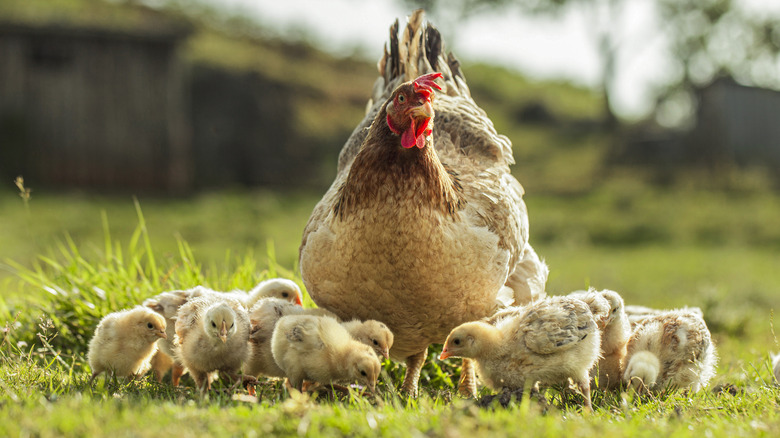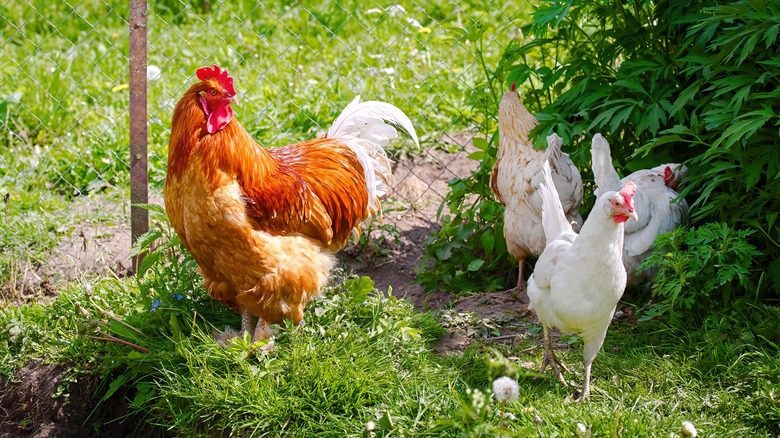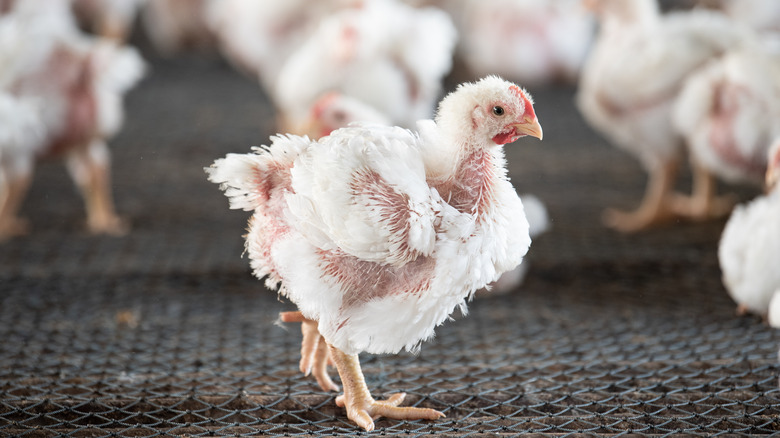What The Heck Were The 'Chicken Of Tomorrow' Contests?
Looking back into the past is always interesting, seeing the similarities and contrasts we of the modern-day share with those living just a few decades behind us. While the 1940s and 1950s, for example, had their differences, many things were the same — people still liked to gossip, read up on the news, have fun, and most importantly, eat good food. Just like today, our grandparents' generation enjoyed nothing more than a good chicken dinner.
Chicken today is quick and easily accessible, be it chicken breasts to fried chicken sandwiches, but poultry in the early half of the 20th century was more of an event — a rare dinner for a special occasion, akin to a steak dinner today. As the National Museum of American History tells us, chicken in the early 1900s was expensive, costing up to $.50 per pound ($22 in today's money) for a bird, making it costly to buy on a regular basis. Even though industrialized farming and transportation made chicken somewhat cheaper, the onset of the Great Depression and World War II forced Americans to make do without. Indeed, the term "a chicken in every pot" was used as a campaign slogan in the 1930s, promising to bring wealth, prosperity, and white meat chicken back to the American people (via American Heritage).
It wasn't until the late 1940s that America began to develop a special breed of chicken that would not only be inexpensive but provide lots of meat– the Chicken of Tomorrow.
A supermarket and the USDA sought the Chicken of Tomorrow
"The Chicken of Tomorrow: the deadly battle against the Chicken of Today!"
Thus quips Mystery Science Theater 3000, reviewing the 1948 short documentary "The Chicken of Tomorrow." Although much of the film is ripe for ribbing and comedy today, one part of the film stands out: there was an organized effort to "breed a better chicken." What does that mean? Who was behind this? And did we ever get the promised chicken of the future?
According to the Institute of Agriculture and Trade Policy, the effort to create the Chicken of Tomorrow was between the defunct grocery chain The Great Atlantic & Pacific Tea Company (better known as A&P) and the United States Department of Agriculture. The goal of the project was simple: breed a chicken that would be low-cost and provide plenty of meat and eggs. Farmers and breeders across the country took part in this noble effort (which included a potential cash prize), submitting the finest eggs from their flocks to be incubated, raised, and harvested for their meat. Whichever chicken yielded the most amount of meat would be declared the winner. Every breed from Jersey Giants to California Greys would be measured and tested to see if they were the model chicken.
In both contests in 1948 and 1951, one single chicken breed came to be known as the "Chicken of Tomorrow," and would soon come to dominate the modern chicken industry.
The Arbor Acre: Your Chicken of Tomorrow
Arbor Acres chickens might not sound familiar, but chances are you've tasted them every time you dug into a Sunday chicken dinner or bit into a piece of KFC. The Arbor Acres brand is the promised Chicken of Tomorrow, described by parent company Aviagen as being bred to "produce chicken efficiently through consistent parent performance, excellent broiler performance, and good processing yield."
For its high meat content, the Arbor Acres breed has become immensely popular. Redcomb Genetics tells us that Arbor Acres hens were the "most successful female worldwide up to the '90s when meat yield performance became increasingly important in the major markets." According to ZPoultry, the Arbor Acres chicken has a live body weight of 2.7 kg (5.9 pounds) in the first six weeks of life, with some being able to go up to 4.3 kg (9.4 pounds) at eight weeks.
Despite this large body, Arbor Acres chickens like to stand upright and are known for their completely white plumage. They are also described as being quite docile and not aggressive, perhaps due to their large size and because they're commonly bred only for meat. Arbor Acres hens also don't lay any eggs. Their passive nature does make them good pets, should you consider raising one. It's up to you and your chicken friend if you want to invite them over for dinner or not, however.


